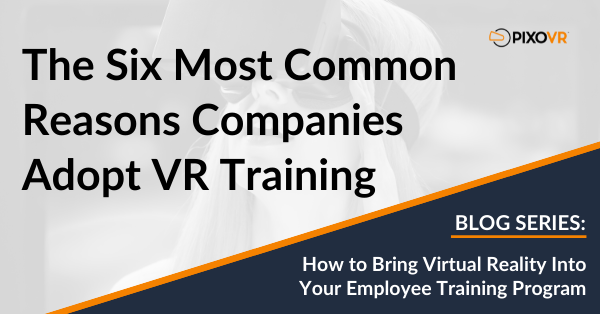The following is an excerpt from our whitepaper: ‘How to Bring Virtual Reality Into Your Employee Training Program’:
Many positive things can be accomplished with VR training, but most companies have different primary factors driving their adoption. Understanding the primary and secondary problems that the company hopes to address with VR training is an important first step to know where to start. Here are the typical drivers to review and determine which fit your business needs best.
To reduce costs – When employee training involves heavy machinery that needs to be taken out of production for the training or when it requires workers or trainers to fly to specific locations to access the equipment needed, these scenarios incur high costs. Companies have found that VR training can be used to simulate the interaction with that equipment and can be done without travel, which eliminates those high costs without reducing training efficacy.
To fill a skilled labor gap – Many companies are facing a severe shortage of skilled workers and are having to train unskilled labor in order to fill these gaps. VR training is an effective way to train hard skills from how to repair equipment to how to do it safely. VR training has been shown to be more effective in a shorter time period in training hard skills so companies can get their labor gaps filled more quickly.
To improve safety – Everyone does safety training, yet workplace injuries still happen. VR training has been shown to be more realistic and effective at safety training than traditional training methods. For instance, VR training on fall protection gives the trainee a realistic perspective of falling—which is much more effective than what the classroom or computer-based training can provide.
To engage a younger workforce – Industries, like fast food, whose workforce is primarily young are turning to VR training as a way to engage their employees and as a competitive advantage in a market where there is a labor shortage. Additionally, VR training helps them reduce job shadowing and ramp up time, also helping them save money.
To enhance soft skills – Diversity training and conflict resolution have become serious issues for companies as they try to improve their culture and minimize lawsuits and unhappy customers. However, it can be challenging to teach these skills in a training room that doesn’t have people of other races or angry customers. VR training for soft skills allows employees to practice conversations with people of other genders and races or who seem genuinely angry. Companies are finding VR training can significantly enhance their existing soft skills training to make it much more engaging and successful.
To improve employee wellness – In a competitive job market where unemployment is high, companies are investing more in retaining their employees and ensuring that they are healthy and happy. VR is being used to help employees learn to take breaks, meditate, and be mindful.
Note, if you create custom content for a client, you can also upload that to the PIXO platform for your clients to access wirelessly and to get the tracking and provisioning capabilities they want.
Download the whitepaper: ‘How to Bring Virtual Reality Into Your Employee Training Program’


Leave a Reply
You must be logged in to post a comment.